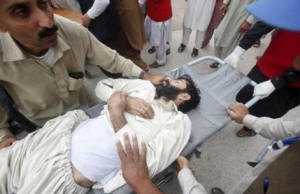|
 At
least 29 dead after strong quake hits Afghanistan, Pakistan At
least 29 dead after strong quake hits Afghanistan, Pakistan
 Send a link to a friend
Send a link to a friend
[October 26, 2015]
KABUL/PESHAWAR, Pakistan (Reuters) -
A powerful earthquake struck a remote area of northeastern Afghanistan
on Monday, shaking the capital Kabul and killing at least 17 people
while 12 were killed in neighboring Pakistan, officials said.
|
|
 Shockwaves were felt in northern India and in Pakistan's capital,
where hundreds of people ran out of buildings as the ground rolled
beneath them. Shockwaves were felt in northern India and in Pakistan's capital,
where hundreds of people ran out of buildings as the ground rolled
beneath them.
The quake was 213 km (132 miles) deep and centered 254 km (158
miles) northeast of Kabul in a remote area of Afghanistan in the
Hindu Kush mountain range.
The U.S. Geological Survey initially measured the quake's intensity
at 7.7 then revised it down to 7.5.
Twelve girls were killed in a stampede while trying to escape from
their school in the north Afghan city of Taloqan while five people
were killed in the eastern province of Nangahar, officials said.
Scores of people were injured.
In northwestern Pakistan, at least 12 people were killed, including
one in the city of Peshawar, according to government officials.
 Injured people were pouring into Peshawar's Lady Reading Hospital,
an official said.
"We received 50 injured and more are being shifted. The injured
suffered multiple injuries due to building collapse," said hospital
spokesman Syed Jamil Shah.
In the Afghan capital, Kabul, buildings shook violently but there
were no immediate reports of damage or injuries.
International aid agencies working in the northern areas of
Afghanistan reported that cell phone coverage in the affected areas
remained down in the hour after the initial quake. India's
northernmost region of Kashmir experienced intense and prolonged
tremors that caused panic in areas that suffered severe flooding
last year. Power supplies and most mobile networks were knocked out,
and there was structural damage to roads and buildings.
[to top of second column] |

No casualties were reported in Indian Kashmir, however.
The earthquake struck almost exactly six months after Nepal suffered
its worst quake on record, on April 25. Including the toll from a
major aftershock in May, 9,000 people lost their lives and 900,000
homes were damaged or destroyed.
The mountainous region is seismically active, with earthquakes the
result of the Indian subcontinent driving into and under the
Eurasian landmass. Sudden tectonic shifts can cause enormous and
destructive releases of energy.
A 7.6 magnitude earthquake struck northern Pakistan just over a
decade ago, on Oct. 8, 2005, killing about 75,000 people.
(Reporting by James Mackenzie and Krista Mahr in Kabul and Jibran
Ahmad in Peshawar; Writing by Nick Macfie and Douglas Busvine;
Editing by Robert Birsel)
[© 2015 Thomson Reuters. All rights
reserved.]
Copyright 2015 Reuters. All rights reserved. This material may not be published,
broadcast, rewritten or redistributed.
 |